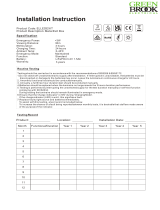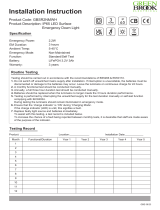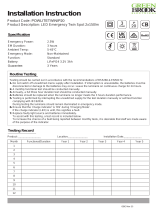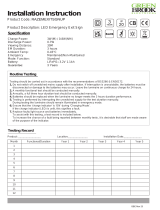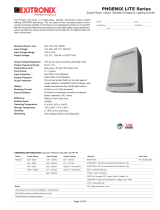
This inverter features an industry-standard 0-10 VDC dimming voltage output which allows emergency operation of one
or more luminaires that consume a total of more than 100 VA when operating in the normal mode, (operating from the
AC mains). These luminaires must have AC drivers (or ballasts) that are compatible with industry standard 0-10 VDC
dimming operation. Existing area dimming controls can be wired through the inverter dimming relay to allow for normal
dimming by occupants of the area during normal mode operation. Refer to Illustration 5 on next page to wire the
dimming output voltage to the load and the input connections from a dimming control device, if used. See Illustration 1
for the location of the dimming connector J2 on the product. The emergency mode dimming voltage can be automatically
controlled by this inverter or can be manually selected by the switch settings of S701 and S702, which are located at the
lower center section of the circuit board (see Illustration 1). See Step 5 for these settings.
NOTICE! Regardless of the inverter dimming method, the power consumed by the connected AC ballasts/LED drivers
during start-up can be signifi cantly higher than their steady state power consumption. When power from any source is
applied to the AC ballasts/LED drivers, the input circuits consume a large amount of power for a few hundred milliseconds.
This short duration power consumption is not the same as inrush current and is typically not mentioned in their speci-
fi cations. It will vary, dependent on the individual AC ballast/LED driver manufacturer. Therefore, the actual number of
dimmable AC ballasts/LED drivers that can be connected to an inverter must be predetermined by testing.
WIRING THE EMERGENCY LIGHTING INVERTER’S DIMMING CONNECTIONS (OPTIONAL)
STEP #4
INSTALLATION
ILLUSTRATION 5
DIMMING CONNECTIONS
SETTING THE OUTPUT DIMMING LEVEL (OPTIONAL)
Upon the loss of normal AC power, the emergency lighting inverter’s internal 0-10Vdc dimming circuit will output a
dimming voltage to the connected luminaires. The inverter features automatic dimming level adjustment (AUTO-DIM) that
will sense and maintain the AC Power output at 100 VA into the connected luminaires. The AUTO-DIM circuit begins at each
loss of AC mains power with the dimming output set to 1 Vdc (approximately 10% light level). For up to 10 seconds, the
dimming voltage gradually increases until the unit senses 100 VA to the load. The dimming voltage level is then main-
tained at that level until AC mains power is restored. The installer may also set the dimming voltage (light level)
manually. Switches S701, S702 on the inverter circuit board are used to manually set the dimming voltage that will
determine the light level during emergency operation. Refer to Illustration 1 on page 2 for the switch locations and
Illustration 6 for switch position settings. The unit must be in the emergency mode to activate this function. If the selected
light level exceeds 100VA, an LED “LOAD” indicator located on the circuit board, next to the switches, will fl ash indicating
that the inverter has exceeded 100 VA output. The AUTO-DIM circuitry will gradually decrease the dimming voltage level until
the power decreases to 100 VA.
STEP #5
DIM- OUT
DIM+ OUT
DIM- IN
DIM+ IN
0-10 VDC + IN
0-10 VDC - IN
0-10 VDC + OUT
0-10 VDC - OUT
INPUT FROM 0-10 VDC DIMMER (OPTIONAL)
OUTPUT TO AC BALLAST 0-10 VDC INTERFACE
J2
ILLUSTRATION 6
DIMMING LEVEL SWITCH SETTINGS
6:,7&+
83
21
6:,7&+
'2:1
2))
5()(5(1&(
To replace the batteries, disconnect both switched and unswitched AC power to the emergency lighting inverter. Remove
the two screws securing the lid to the enclosure base and remove the lid. Open the inverter connector wires and then
unplug and remove the old batteries. Reverse this process to install the new batteries. Remember to join the inverter
connector prior to reinstalling the lid. The charging indicator light should be illuminated once unswitched AC power is
restored. Use only inverter part number PRT00133 as replacement batteries. Utilisez uniquement la référence inverter
PRT00133 en tant que remplacement de la batterie.
BATTERY REPLACEMENT
4






